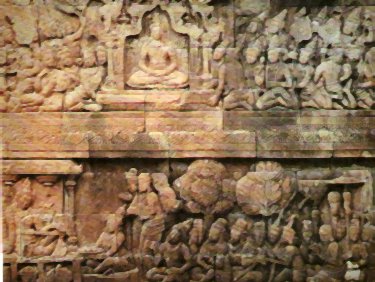
RUPADHATU - Sphere of Form
Via a landing in the stairway, today's visitor to Borobudur enters the first so - called gallery. This is the lowest of our four gallery which make up the "Rupadhatu", or the second spiritual of Buddhism. In it, all human desire has disappeared, just the forms of our world still prevail. This is generally the sphere of the Bodhisattvas, who - although of human form - have nevertheless renounced lust and desire and are close to deliverance. The first gallery holds clockwise two superimposed series of reliefs, on the balustrade as well as on the main wall. The upper series of reliefs on the balustrade depicts Buddha's spiritual life, while the main wall shown his earthly life.

The balustrade of the first gallery should accomodate a total of 104 Manushi - Buddhas in open niches. Those at the four corners of the monument point to the four compass directions. In the Buddhist hierarchy, the Manushi Buddhas, because of their earthly manifestation, represent the lowest degree of holiness. It is relatively easy to recognize a Budhha by his stature, posture and clothes. He is dressed in a grown which, in a sitting position, leaves the right shoulder bare. His hair consist of small curls, which are arranged around his head in right-hand spirals, in the centre of which is a small upright braid. Except for one single posture, in which Buddha carries a bowl, his hands are always free. Meaning and symbol lie in the different hand positions (Mudra), they may assume a teaching, reassuring, warning or reasoning attitude; seven different Buddha characters have been found at Borobudur.
 After
ascending another flight of stairs, the visitors will find himself in the second
gallery. The reliefs are a continuation of the stories from the first gallery,
with the only difference that they are single, full height pctorial panels and
not in two rows. The Budhhas of the second balustrade - there should be 104
Buddhas - belong to the "Dhyani" group, the so - called meditation
Buddhas. They are the rulers of the four winds of heaven; Akshobhyn in the East
- Amogasiddha in the North - Amithaba in the West and Ranasambhawa in the South.
The Dhyani Buddhas also differ through their varying symbols according to their
direction.The
Buddhas facing east are calling the earth as witness; those facing north symbolize
fearlessness; Buddhas facing west are lost in meditation and those on the south
side symbolize charity and mercy.
After
ascending another flight of stairs, the visitors will find himself in the second
gallery. The reliefs are a continuation of the stories from the first gallery,
with the only difference that they are single, full height pctorial panels and
not in two rows. The Budhhas of the second balustrade - there should be 104
Buddhas - belong to the "Dhyani" group, the so - called meditation
Buddhas. They are the rulers of the four winds of heaven; Akshobhyn in the East
- Amogasiddha in the North - Amithaba in the West and Ranasambhawa in the South.
The Dhyani Buddhas also differ through their varying symbols according to their
direction.The
Buddhas facing east are calling the earth as witness; those facing north symbolize
fearlessness; Buddhas facing west are lost in meditation and those on the south
side symbolize charity and mercy.
 After
ascending yet another flight of steps, the third gallery opens itself to the
eye. Reliefs and balustrade hardly differ from stage below. While the first
stage of the Buddhist sphere of existence is considered the World of Desire,
the second stage become the Sphere of Form. The second Buddhist sphere ends
with the fourth gallery. The meaning of the reliefs on the outside wall of the
gallery is largely unknown, or cannot be attached to one of the familiar myths
or stories. There is no doubt, however, that they are illustrations of the most
advanced Buddha of the future. The reliefs on the opposite inside wall describe
the life of the least advanced Buddha of the future. It is said the Javanese
followers of Buddhism were particularly devoted to this latter Buddha. The balustrade
should accomodate 72 Buddhas, just a little smaller than the others, thus maintaining
the overall propositions of this stage.
After
ascending yet another flight of steps, the third gallery opens itself to the
eye. Reliefs and balustrade hardly differ from stage below. While the first
stage of the Buddhist sphere of existence is considered the World of Desire,
the second stage become the Sphere of Form. The second Buddhist sphere ends
with the fourth gallery. The meaning of the reliefs on the outside wall of the
gallery is largely unknown, or cannot be attached to one of the familiar myths
or stories. There is no doubt, however, that they are illustrations of the most
advanced Buddha of the future. The reliefs on the opposite inside wall describe
the life of the least advanced Buddha of the future. It is said the Javanese
followers of Buddhism were particularly devoted to this latter Buddha. The balustrade
should accomodate 72 Buddhas, just a little smaller than the others, thus maintaining
the overall propositions of this stage.
Back to Map of Borobudur Library Contact us
© INSIST 2001